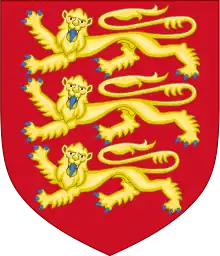
Richard le Scrope, 1st Baron Scrope of Bolton (c. 1327 – 30 May 1403) was an English soldier and courtier, serving Richard II of England.[1] He also fought under the Black Prince at the Battle of Crecy in 1346.
Biography
Richard le Scrope was a Knight of the Shire for Yorkshire in the parliament of 1364, and was summoned to the upper house as a baron by writ in 1371, when he was made Lord High Treasurer and Keeper of the Great Seal.
In 1378 Lord Scrope became Lord Chancellor, a role in which he attempted to curb the extravagance of Richard II, but resigned in 1380 when the government collapsed due to military failures in France. After the turbulence of the Peasants' revolt, in which his successor was beheaded by the rebels, he took up the position again. He was finally deprived of office by King Richard for non-cooperation in 1382 and thereafter dedicated himself to the rebuilding of Bolton Castle on his estates in Wensleydale in Yorkshire, for which he had been given licence to crenellate.[2] [3] [4]
Both as a soldier and a statesman Lord Scrope was highly regarded and the new king Henry IV was moved to confirm that his lands and titles would not be forfeit in spite of the fact that his eldest son William had been executed by Henry in 1399 for William's support of Richard II. Richard Scrope died on 30 May 1403 in Pishobury, Hertfordshire (where he had bought a country estate) and was buried at Easby Abbey in Richmond, Yorkshire. His title passed to his second son Roger Scrope.[5]
Heraldic litigant
Scrope engaged in several disputes with regard to his armorial bearings, the most celebrated of which was with Sir Robert Grosvenor[6] for the right to the shield blazoned "Azure, a bend Or," which a court of chivalry decided in his favour after a controversy extending over four years (see Scrope v Grosvenor).
Geoffrey Chaucer and Owain Glyndŵr gave evidence in Scrope's favour.
Family
He was a son of Henry le Scrope.[7] Richard le Scrope, Archbishop of York, was a first cousin.[8]
He married Blanche de la Pole (daughter of William de la Pole of Hull), by whom he had four sons:[9]
- William le Scrope, 1st Earl of Wiltshire
- Roger le Scrope, 2nd Baron Scrope of Bolton
- Stephen le Scrope (died 1408)[10]
- Richard le Scrope
Footnotes
- ↑ Rosenthal, Joel Thomas (1991). Patriarchy and Families of Privilege in Fifteenth-Century England. University of Pennsylvania Press. p. 78. ISBN 9780812230727.
- ↑ Castles of the Yorkshire Dales · [ Bolton Castle ] · written by Glyn Harris for Daelnet's The Yorkshire Dales
- ↑ Bolton Castle
- ↑ Bolton Castle on AboutBritain.com
- ↑ Baron Scrope of Bolton
- ↑ Heraldry in Castle Combe
- ↑ Henry Le Scrope – Inherited Manor of Bolton in 1303
- ↑ SCROPE
- ↑ SCROPE
- ↑ Burke, John (1836). A Genealogical and Heraldic History of the Commoners of Great Britain and Ireland. Vol. 3. p. 696.
References
- Vale, Brigette (1987). The Scropes of Bolton and of Masham (PhD). University of York, Department of History.
- Vale, Brigette (2004). "Scrope, Richard, first Baron Scrope of Bolton". Oxford Dictionary of National Biography (online) (online ed.). Oxford University Press. doi:10.1093/ref:odnb/24963. (Subscription or UK public library membership required.)
